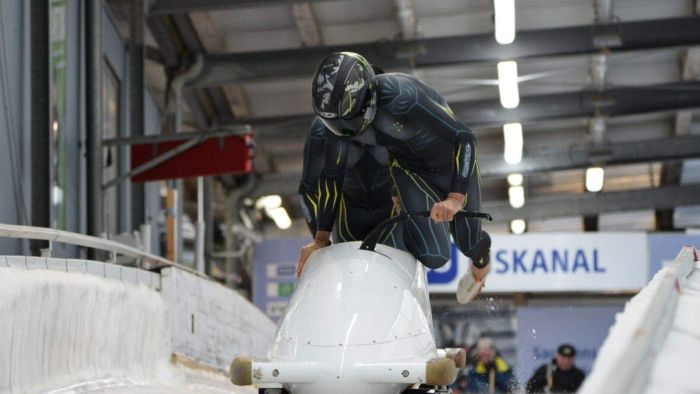Racing down an ice chute in a bobsleigh at 130 to 140 kilometres per hour is not for the faint-hearted.
Key points:
It is hard on the body, and on the hip pocket, but determined Australian bobsleigh athletes are taking their place on the world stage.
But its pull remains strong on athletes like Joe Williamson.
“There’s nothing that compares.”
From Switzerland to Queensland
Bobsleigh is a winter sport invented by the Swiss in the late 1860s in which teams make timed runs down narrow, twisting, banked, iced tracks in a gravity-powered sled.
Williamson was born and raised in coastal Queensland, where winter temperatures rarely get below 10 degrees Celsius, and there is no snow.
But that has not stopped him becoming a bobsleigh brakeman, part of a team representing Australia at the World Championships in Europe in the new year, and chasing a berth at the 2022 Beijing Winter Olympics.
Born in Bundaberg, and now living on the Sunshine Coast, Williamson fell into the winter sport three years ago.
“I was track sprinting and beach sprinting, and I was just running some gift races in Victoria,” he said.
“I had a gentleman who used to be a push athlete for Australia approach me and say, ‘Hey look — you’re big, you’re quick, and you could have some potential to do this [bobsleigh racing], do you want to have a crack?’
“But it is a thing … and about six weeks later I was booking flights to Norway and getting in a sled.”
On Boxing Day, while most Aussies are sitting in front of the fan watching the cricket on TV, having a barbeque by the pool or heading to the beach, Williamson will be travelling to a wintery Germany for pre-competition training on the ice with Sydney pilot Evan O’Hanlon.
Queensland athletes on the world stage
Williamson and O’Hanlon have a quota spot at the International Bobsleigh and Skeleton World Championships in Altenberg, Germany, in February.
Cairns bobsleigh pilot Breeana Walker is one of Australia’s best sliding sports athletes and she will be competing in Germany too.




This month Walker became the first Australian to win a World Cup gold medal in sliding sports, when she took out the monobob race, a solo bobsleigh event for women that will be part of the Winter Olympics for the first time at Beijing in 2022.
“This year we have found an incredible coach and upgraded equipment, all at a substantial expense for a team that is primarily self-funded.”
‘We are severely underfunded’
It is more than 30 years since Australia first competed in an Olympic bobsleigh event at Calgary in 1988, but the sport remains severely underfunded.
“A typical season for a two-person team will cost between $60,000 to $80,000, and that’s without purchasing high-end equipment,” Bobsleigh and Skeleton Australia chief executive, Hayden Smith, said.
“That budget would be ideal for two people, or a three-person team, and we’ve got a third of that to spread across 30 [skeleton and bobsleigh] people.
Smith said their four-man team to the Pyeongchang Olympics in 2018 received only $15,000 funding.
“We would have spent north of $100,000 that season as a group of four guys, easily,” he said.
“Everyone was maxing out their credit cards and spending their savings to do it.”




The cost of bobsleighs is a major issue, meaning Australian athletes compete on older sleds while other countries have the latest equipment, making it harder to compete.
As Joe Williamson prepares to fly out for a stint on the ice, covering the costs of the sport he loves is front of mind.
“We need to be there for close to five months really, to get the run volume in, and get the pilot’s eye.”







